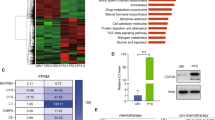Abstract
Background
Decay-accelerating factor (DAF) is one of the key molecules involved in cell protection against autologous complement, which restricts the action of complement at critical stages of the cascade reaction. The effect of DAF on the survival of human cervical cancer cell (ME180) has not been demonstrated.
Methods
In this study we applied, for the first time, small interference RNA (siRNA) to knock down the expression of the DAF with the aim of exploiting complement more effectively for tumor cell damage. Meanwhile, we investigated the effects of DAF on the viability and migration, moreover the proliferation of ME180 cell.
Results
The results showed that the expression of DAF was significantly increased in human cervical cancer tissues. SiRNA inhibition of DAF expression enhanced complement-dependent cytolysis up to 32% in ME180 cells, which contributed to the control of C3 activation and increased the cells viability, migration and augment the number of ME180 cells.
Conclusion
These data indicated that DAF siRNA described in this study may offer an additional alternative to improve the efficacy of antibody- and complement-based cancer immunotherapy.




Similar content being viewed by others
References
Andersson S, Hellstr AC, Ren ZP et al (2006) The carcinogenic role of oncogenic HPV and p53 gene mutation in cervical adenocarcinomas. Med Oncol 23:113–119
Arora M, Arora R, Tiwari SC et al (2000) Expression of complement regulatory proteins in diffuse proliferative glomerulonephritis. Lupus 9:127–131
Bjorge L, Hakulinen J, Wahlstrom T et al (1997) Complement-regulatory proteins in ovarian malignancies. Int J Cancer 70:14–25
Bosch FX, Sanjose S (2003) Human papillomavirus and cervical cancer-burden and assessment of causality. J Natl Cancer Inst Monogr 31:3–13
Castellsague X, Diaz M, Sanjose S et al (2006) Worldwide human papillomavirus etiology of cervical adenocarcinoma and its cofactors: implications for screening and prevention. J Natl Cancer Inst 98:303–315
Cole DS, Morgan BP (2003) Beyond lysis: how complement influences cell fate. Clin Sci 104:455–466
García VI, Atisha FY, Richaud PY et al (2006) Diminished expression of complement regulatory proteins (CD55 and CD59) in lymphocytes from systemic lupus erythematosus patients with lymphopenia. Lupus 15:600–605
His BL, Hunt JS, Atkinson JP et al (1991) Differential expression of complement regulatory proteins on subpopulations of human trophoblast cells. J Reprod Immunol 19:209–223
Holmes CH, Simpson KL, Wainwright SD et al (1990) Preferential expression of the complement regulatory protein decay accelerating factor at the fetomaternal interface during human pregnancy. J Immunol 144:3099–3105
Jemal A, Siegel R, Ward E et al (2006) Cancer statistics. J Clin 56:106–130
Kiso T, Mizuno M, Nasu J et al (2002) Enhanced expression of decay-accelerating factor and CD59/homologous restriction factor 20 in intestinal metaplasia, gastric adenomas and intestinal-type gastric carcinomas but not in diffuse-type carcinomas. Histopathology 40:339–347
Li L, Spendlove I, Morgan J et al (2001) CD55 is over-expressed in the tumour environment. Br J Cancer 84:80–86
Parkin DM, Bray F, Ferlay J et al (2001) Estimating the world cancer burden: Globocan 2000. Int J Cancer 94:153–156
Richaud PY, Pérez RB, Carrillo ME et al (2003) Deficiency of red cell bound CD55 and CD59 in patients with systemic lupus erythematosus. Immunol Lett 88:95–99
Van BJ, Van MM, Hart BA et al (2005) Decay-accelerating factor (CD55) is expressed by neurons in response to chronic but not acute autoimmune central nervous system inflammation associated with complement activation. J Immunol 174:2353–2365
Zell S, Geis N, Rutz R et al (2007) Down-regulation of CD55 and CD46 expression bu anti-sense phosphorothioate oligonucleotides (S-ODNs) sensitizes tumour cells to complement attack. Clin Exp Immunol 150:576–584
Acknowledgments
The study was supported in part by Nan**g Medical University Natural Science Foundation (No.08NMUZ031) and Nan**g Health Bureau Medical Science Foundation (No. YKK08112).
Author information
Authors and Affiliations
Corresponding author
Additional information
The authors L.-J. Gao and L. Ding contributed equally to this work.
Electronic supplementary material
Below is the link to the electronic supplementary material.
Rights and permissions
About this article
Cite this article
Gao, LJ., Ding, L., Guo, SY. et al. Role of decay-accelerating factor in regulating survival of human cervical cancer cells. J Cancer Res Clin Oncol 137, 81–87 (2011). https://doi.org/10.1007/s00432-010-0862-3
Received:
Accepted:
Published:
Issue Date:
DOI: https://doi.org/10.1007/s00432-010-0862-3




